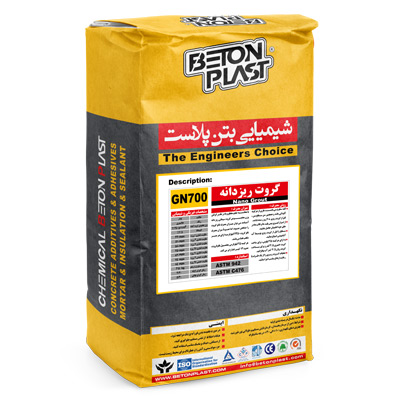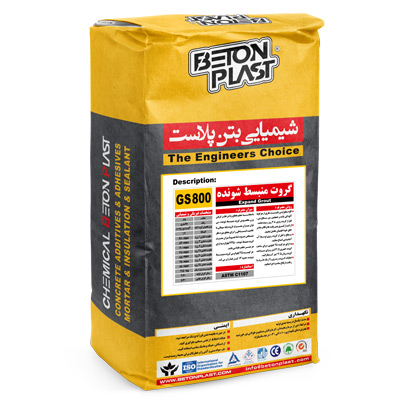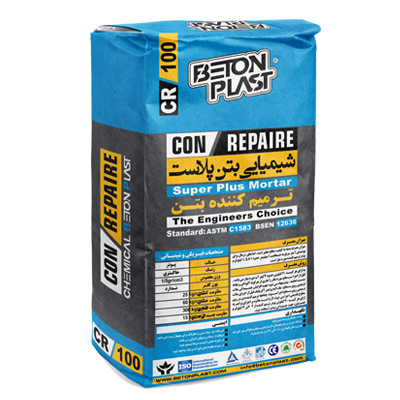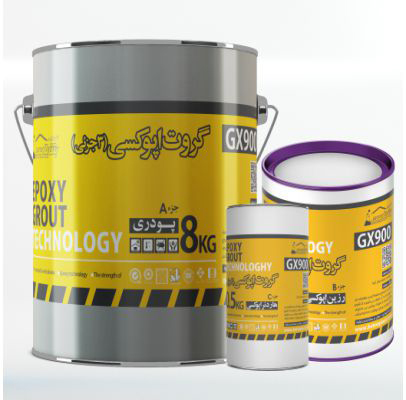Nano Grout
- No cracking after hardening
- Acquisition of initial and final high resistance in the early ages of Grout
- Contained, controllable expansion
Description
Nano Grout
To address this issue, it is crucial to use a grout with an appropriate particle size distribution. This grout should easily pass through the dense rebar, maintain good workability, and not require vibration. Nano Grout is an ideal solution for these situations. Due to the special particle size distribution (maximum of one millimeter), this grout easily flows through the dense reinforcement, while also offering desirable properties such as high strength and no shrinkage.
Due to specific conditions and structural calculations, some concrete sections have a high density of reinforcement, making it virtually impossible for aggregate particles in the grout to pass through in certain areas. Additionally, vibrating these dense sections is highly challenging. This situation has made grouting in high-reinforcement sections one of the main concerns for contractors.
In sections with a high concentration of rebar, the size of the aggregates in normal cement-based grouts can prevent the grout from flowing uniformly and homogeneously throughout the section. This can cause the aggregates to get stuck in some areas, ultimately reducing the concrete quality in those locations.
More products ; grout
Features Nano Grout
- Exhibits high resistance to static loads.
- Remains crack-free after hardening.
- Does not undergo any shrinkage or contraction during the curing process or afterward.
- Has optimal workability without the need for additional superplasticizers.
- Due to the inclusion of superplasticizer in the formulation, it requires minimal water for mixing.
- Provides controlled expansion.
- Has a high setting speed after application.
- Achieves high early and final strength at early ages.
- Easily used in areas with high reinforcement density due to its excellent workability and finer gradation.
- Has lower permeability compared to other similar cement-based grouts due to the absence of filler shortage and fine aggregates.
- Creates controlled, restrained expansion.
- Controlled free expansion is achieved.
- Offers excellent workability without bleeding or segregation.
- Allows for early loading and faster use of the structure.
- Due to its finer particles, it provides more uniform distribution during mixing.
- Has superior mechanical properties compared to regular grouts.
- Prevents cracking.
- Offers good resistance to chemical attacks and corrosive environments.
- Provides better adhesion to various surfaces.
Applications
- Ideal for filling the gaps under base plates or column bases.
- Suitable for the foundation of heavy machinery and their installation and stabilization.
- Perfect for steel substructures and stabilizing precast columns.
- Capable of filling spaces around rebar and anchor bolts.
- Excellent for filling spaces under conveyor rails in industrial factories.
- Suitable for creating strong concrete foundations under various structures.
- Works well for masonry and repair tasks within apartments and homes as a high-strength mortar.
- Ideal for installing and stabilizing precast columns and walls.
- Perfect for filling the gap between bridge piers and deck.
- Suitable for filling spaces between two concrete surfaces where a durable grout is needed.
- Can be used as new concrete on top of existing concrete surfaces.
- Ideal for grouting bolt holes and concrete box sections.
- Works effectively as a repair mortar in deep sections.
- Suitable for filling cavities, cracks, and holes in various structures.
Usage Instructions for Nano grout
- Ensure that the plates are accurately positioned in their place. If necessary, check the leveling of the base plates using a level.
- The cement or concrete surface where the grout will be applied should be at least 7 days old.
- There should be a minimum of 1 cm gap between the underside of the plates and the concrete surface.
- All surfaces that will come into contact with the fine-grain grout must be free from contaminants, such as grease, oil, dust, or debris.
- If there are loose or flaky areas on the concrete surface, they should be cleaned using a grinder, water jet, or other physical methods to achieve a solid, reliable surface.
- The molds should be resistant to permeability.
- The height of the molds should be between 2 to 5 cm above the base plates.
- To prevent air bubbles when pouring the fine-grain grout, use a headbox for large grouting projects and a 50 cm-wide sheet with a 45-degree slope for smaller ones. This ensures that the nanogrout moves uniformly and continuously.
- Before applying the grout, the surface should be saturated with drinking water to prevent the dry surface from absorbing the grout’s water and causing cracking.
- Use an appropriate container for mixing the grout powder with water. For each 25 kg bag, 3.5 liters of water are needed for a paste-like grout and 4.5 liters for a fluid grout.
- Gradually add the powder to the water while the electric mixer (drill with paddle) is running, continuing until a homogeneous mixture is obtained.
- The grout mixture should be used within 30 minutes of preparation.
- No additives, cement, or aggregates should be added to the prepared fine-grain grout.
- Grouting should always be performed from one side, and it should flow to other areas under its own weight. For better flow, metal rods or chains can be used as an aid.
- For large sections, it is recommended to divide the area into smaller parts using temporary molds.
- Ensure that there is enough empty space under the base plates to prevent air from being trapped.
- The temperature of the environment during grouting should be between 5 to 30°C. Temperatures above 30°C will speed up the curing process, while temperatures below 5°C will delay initial curing.
- In extreme temperatures, the grout powder should be stored in its original packaging and in a sheltered area.
- In hot weather, use cold water for mixing, and in cold weather, use warm water.
- After completing the grouting and reaching initial set, cover the mold and equipment with a damp burlap layer to prevent water evaporation. Then, cover the burlap with a plastic sheet.
- After grouting, surface curing should be carried out for 7 days.
Technical specification table
| state of | powder |
| Color | Gray |
| Special Weight | 3/2 gr/cm3 |
| Chlorine ion | does not have |
Package:
25kg bag






Reviews
There are no reviews yet.